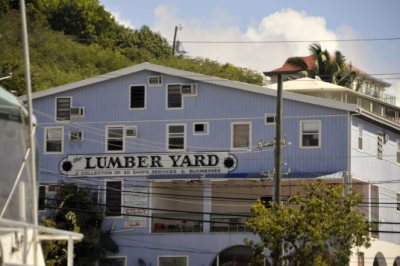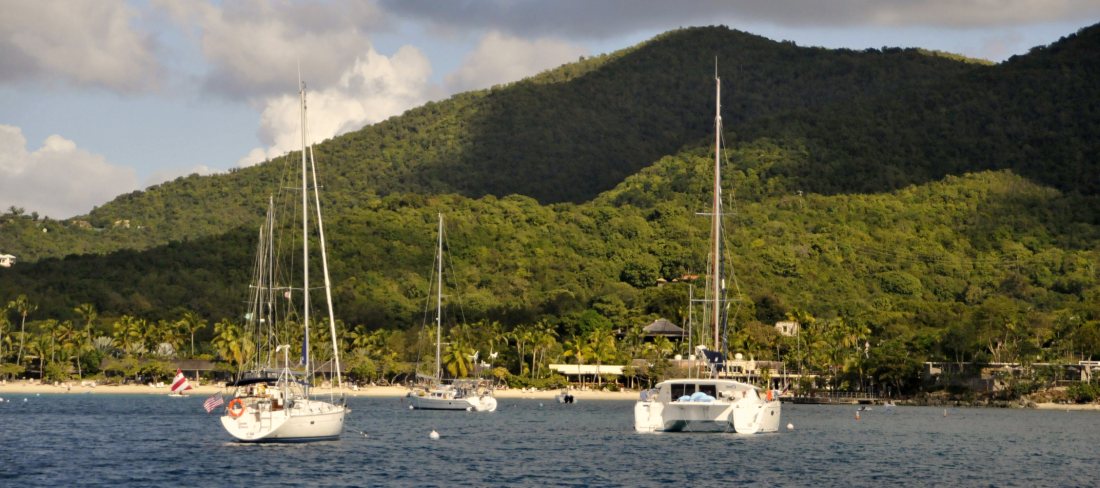St John

|
Saint John, U.S. Virgin
Islands
We dragged ourselves away from the BVI's with
a brand new At-Venture to pastures new. Time for Bear to
hoist the USVI flag. From Great Bay to Caneel Bay was a whooping six mile
journey but bravery and enthusiasm got the better of us. We knew it was tight to
get anchored in Cruz Bay so we took a buoy and dinghied round to Customs and
Immigration. We expected this to be a lengthy process going on the experiences
we have had just passing through New York en route flying to the UK. We were
pleasantly surprised that it took just a few minutes. Then off for a little
explore of Cruz and find a supermarket.
 Saint
John is an constituent district of the United States Virgin Islands, an unincorporated territory of the United States. St. John is an exclusive travel and honeymoon
destination with several resorts and one of the top ten beaches in the world. It
is also considered to be the wealthiest and most expensive of the USVI's,
attracting a high level of affluent tourists. The island's high level of
affluence has earned it the distinction of being the "Beverly Hills of the
Caribbean". St. John is located about four miles east of Saint Thomas, the
location of the territory's capital, Charlotte Amalie, and four miles south and west of Tortola in the BVI's. It is
nineteen point six one square miles in area and has a population of 4,197 (2000 census). Because there
are no airports on St. John, the only access to the island is by boat. The ferry
service runs hourly from St. Thomas and daily from Tortola; regular
ferries also operate from Virgin Gorda, Jost Van Dyke and three times a week to
Anegada.
History: St. John was first settled by the Arawak Indians who had migrated north from coastal Colombia and Venezuela around AD 300. The Arawaks inhabited the island until around the year AD 1300, when they were driven off by the more aggressive and warlike Carib Indians. Extensive archaeological work has been undertaken from 1996 to the present at Cinnamon Bay, the artifacts from this dig are currently being studied and should yield more detailed information on pre-Columbus civilization in the Virgin Islands (Taino). Christopher Columbus is credited with being the first European to see the Virgin Islands during his second voyage to the New World in 1493. He named the island group "Once Mil Virgenes", or Eleven Thousand Virgins, in honour of the feast day of Saint Ursula and the 11,000 virgins who were martyred with her.
 Cruz Bay
The Danish West India and Guinea Company represented the first Europeans to settle the island in 1718. They are also credited with naming the island St. John (Danish: Sankt Jan). The Danish crown took full control of the colony in 1754, along with St. Thomas and St. Croix. Sugar plantations, such as the famous Annaberg Sugar Plantation, were established in great numbers on St. John because of the intense heat and fertile terrain, which provided ideal growing conditions. The establishment of sugar plantations also led to the importation of more slaves from Africa. St. John was the site of one of the first significant slave rebellions in the New World in 1733, when enslaved Akwamu rebels from the Gold Coast took over the island for six months. The Danish were able to defeat the enslaved Africans with help from the French in Martinique. Instead of allowing themselves to be recaptured, more than a dozen men and women shot themselves before the French forces could capture them. It is estimated that by 1775, slaves outnumbered the Danish settlers by a ratio of 5:1. The indigenous Caribs and Arawaks were also used as slave labour, to the point of wiping out their entire population. Slavery was finally abolished in St. John on the 3rd of July 1848. In 1917 the US purchased the U.S. Virgin Islands for $25 million from the Danish
government in order to establish a naval base whose purpose was to prevent
German expansion in the Western Hemisphere. They also agreed to recognise Denmark's claim to
Greenland, which they had previously disputed. US Virgin Islanders are US citizens, although they cannot vote in presedential elections and have only non-voting status in Congress. Since 1972, they have elected their own Governor. They enjoy a large degree of self-rule through a local 15-seat
legislature that covers all three of the islands. In 1956, Laurance Rockefeller donated most of the land he had acquired on the island to the United
States' National Park Service, under the condition that it must be protected from future
development. The remaining portion, the Caneel Bay Resort, continues to operate on a lease arrangement while the park
owns the actual land. The Virgin Islands National Park borders encompass 75% of the island, but various in-holdings within
the park boundary (e.g., Peter Bay, Maho Bay) reduce the actual land the park
owns to 60%. However, much of the island's waters, coral reefs and shoreline are protected via their inclusion in the park. This
protection was expanded in 2001, when the Virgin Islands Coral Reef National
Monument was created.
 
The National Park Visitors Centre, Cruz Bay. This Lumber
Yard building houses many small interesting shops
Cruz Bay has become the principal town on the island since the ferry service from St. Thomas became the main route of entry to the island. Previously, Coral Bay was the hub of economic activity on the island, as its natural port offered protection to the sailing vessels of the day as well as an easy sail that involved minimal tacking to the nearby British Virgin Islands. In fact, until the late 20th century the residents of Coral Bay and East End had easier and more frequent access to Tortola than those of either Cruz Bay or St. Thomas.
Tourism and sites: St. John is well known for its well-preserved natural beauty and
attractive beaches. Restricted development and preservation in St. John
contrasts heavily with such adjacent and overdeveloped islands as St. Thomas and
St. Maarten. Where St. John is developed, the establishments are posh and
upscale; adding to the island's ever increasing sense of exclusivity. Dining
options are abundant with various types of cuisines to choose from. Tourists
enjoy picturesque hills dotted with opulent villas of the wealthy and elite.
Cruz Bay on the western coast of the island is St. John's principal port. From
there, a ferry operates throughout the day to and
from Charlotte Amalie and Red Hook in St. Thomas. It is also home to (among other things) car rental
locations, several restaurants, and a couple of supermarkets. Coral Bay on the eastern side of the island is the other (smaller)
town on St. John, and offers some of the same amenities. Most of St. John is National Park land, so most of the island is undeveloped. Some of the most popular beaches in the Caribbean are located along the island's north shore. The most spectacular and well-known of these is Trunk Bay, which has consistently been voted one of the "Ten Best Beaches in The World" by Conde Nast Traveler magazine and has received similar recognition from other publications. Since the beaches are on National Park land, they are all open to the public and are free of hotels or resorts. A notable exception is the Caneel Bay resort on the north shore, which lies on Rockefeller’s former personal estate. The remaining coastal land, mostly in the north and in the east, is private property, and contains many secluded private villas and cottages. The National Park Service also offers two campgrounds on the island's beaches at Maho Bay and Cinnamon Bay. The reefs near St. John's beaches are also world-famous for their snorkeling. In some areas, such as Trunk Bay and nearby Cinnamon Bay, signs identifying various marine flora and fauna have been placed by the National Park Service among the many offshore coral reefs to assist visitors.
Popular Culture: At the end of John Grisham's best selling novel The Pelican Brief the
hero's escape to St. John. Specifically, a small cottage in Maho Bay, along the
North Shore of St. John.
We buoyed on the northern part of Caneel Bay for the night, a Park Ranger took our details without speaking to us, we learned this is just to keep an eye on folk
ALL IN ALL LOOKING FORWARD TO RETURNING TO EXPLORE PROPERLY |


